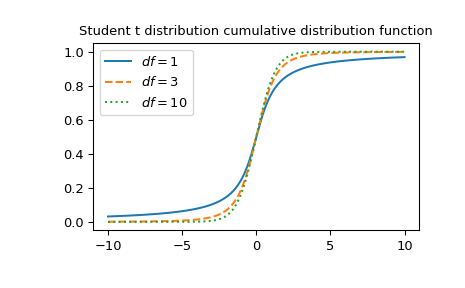scipy.special.stdtr#
- scipy.special.stdtr(df, t, out=None) = <ufunc 'stdtr'>#
学生 t 分布累积分布函数
返回积分
\[\frac{\Gamma((df+1)/2)}{\sqrt{\pi df} \Gamma(df/2)} \int_{-\infty}^t (1+x^2/df)^{-(df+1)/2}\, dx\]- 参数:
- dfarray_like
自由度
- tarray_like
积分上限
- outndarray, optional
函数结果的可选输出数组
- 返回:
- 标量或 ndarray
在 t 处的学生 t CDF 值
另请参见
stdtridfstdtr 关于 df 的逆函数
stdtritstdtr 关于 t 的逆函数
scipy.stats.t学生 t 分布
说明
学生 t 分布也可通过
scipy.stats.t获得。直接调用stdtr可以比调用scipy.stats.t的cdf方法提高性能(参见下面的最后一个示例)。除了 NumPy 之外,
stdtr对 Python 数组 API 标准兼容的后端提供实验性支持。请考虑通过设置环境变量SCIPY_ARRAY_API=1并提供 CuPy、PyTorch、JAX 或 Dask 数组作为数组参数来测试这些功能。支持以下后端和设备(或其他功能)的组合。库
CPU
GPU
NumPy
✅
不适用
CuPy
不适用
✅
PyTorch
✅
⛔
JAX
✅
✅
Dask
✅
不适用
有关更多信息,请参阅 对数组 API 标准的支持。
示例
计算
df=3在t=1处的函数。>>> import numpy as np >>> from scipy.special import stdtr >>> import matplotlib.pyplot as plt >>> stdtr(3, 1) 0.8044988905221148
绘制三种不同自由度下的函数。
>>> x = np.linspace(-10, 10, 1000) >>> fig, ax = plt.subplots() >>> parameters = [(1, "solid"), (3, "dashed"), (10, "dotted")] >>> for (df, linestyle) in parameters: ... ax.plot(x, stdtr(df, x), ls=linestyle, label=f"$df={df}$") >>> ax.legend() >>> ax.set_title("Student t distribution cumulative distribution function") >>> plt.show()

通过为 df 提供 NumPy 数组或列表,可以同时计算多个自由度下的函数。
>>> stdtr([1, 2, 3], 1) array([0.75 , 0.78867513, 0.80449889])
通过为 df 和 t 提供形状兼容以进行广播的数组,可以同时计算多个不同自由度下多个点的函数。计算 3 个自由度在 4 个点处的
stdtr,得到一个形状为 3x4 的数组。>>> dfs = np.array([[1], [2], [3]]) >>> t = np.array([2, 4, 6, 8]) >>> dfs.shape, t.shape ((3, 1), (4,))
>>> stdtr(dfs, t) array([[0.85241638, 0.92202087, 0.94743154, 0.96041658], [0.90824829, 0.97140452, 0.98666426, 0.99236596], [0.93033702, 0.98599577, 0.99536364, 0.99796171]])
t 分布也可通过
scipy.stats.t获得。直接调用stdtr可能比调用scipy.stats.t的cdf方法快得多。为了获得相同的结果,必须使用以下参数化:scipy.stats.t(df).cdf(x) = stdtr(df, x)。>>> from scipy.stats import t >>> df, x = 3, 1 >>> stdtr_result = stdtr(df, x) # this can be faster than below >>> stats_result = t(df).cdf(x) >>> stats_result == stdtr_result # test that results are equal True